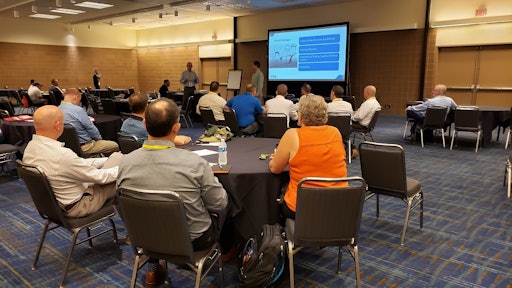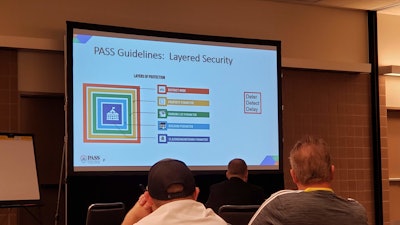
Two school safety experts shared the latest best practices in an educational seminar, “Become a Safety and Security Resource to Your School Clients,” at the DHI ConNextions conference on Oct. 20 in New Orleans.
The session was led by Mark Williams, board chairman at Partner Alliance for Safer Schools (PASS) and Paul Timm, vice president of Facility Engineering Associates. The two have used PASS guideline and checklist tools in their own work and discussed ways contractors and those in the door hardware industry can help schools follow national standards.
The PASS School Safety and Security Checklist allows contractors and others to track a school’s or district’s security efforts in comparison to the best practices defined in the guidelines.
The list of the best practices detailed in the PASS Guidelines can be used to assess what may need to be implemented by a school or district. These guidelines can help professionals identify whether they have the recommended school security best practice in place, in progress, needed for the future or not required for a facility.
“Whether you are a parent, a student, a teacher, a school administrator, emergency response, or an active member of your community, we can all agree school safety is important,” Williams says. “How will they keep schools safe though? It involves so many choices and decisions. Wouldn't it be nice to know what other schools have done? What worked for them? What didn't work for them?”
PASS guidelines were designed to help schools make decisions about security and minimize mistakes.
“We heard from one of our school superintendents is, ‘you know, I don’t want to be the first to try something,’” Williams says. “They want to know someone else has tried this and implemented it successfully. School decisions are tough to make. They want to avoid mistakes.”
In the world of access control, one of the most common mistakes schools make is using non-code compliant locking devices, Williams says.
Creating a more safe and secure school requires several steps. One of those is creating a unified system within the school, where communication systems connect to alarm systems, which also connect to video surveillance and so on. But knowing what to implement first can be puzzling, he says.
“How does all this stuff work together as a system that schools can utilize, understand and afford? And then how do they know what to do first? These are all issues schools grapple with,” he says.
Emergency management systems focus on prevention, detection, mitigation, response and recovery. PASS guidelines focus on the initial steps: prevention, protection and mitigation. From there, PASS concentrates on the building blocks of security, which are deterrents, detection and delay, followed by plan, prepare, practice.
“Our goal is to deter, detect and delay adversarial behavior and the way we do that is by planning, preparing and practicing,” Williams says.
While implementing such systems in schools may seem complex, PASS’ goal is to keep educational buildings welcoming and accessible.
“We’re not going to cause people to swim the moat to get into the school but what we are going to do is follow the principles of layered security,” Timm says. “We’re going to make sure that before they even make it to the property, that we have controlled the access and we have set up the barriers and we’ve asked them to come into a place where we can authorize them. And we can make that all happen without having a look of Fort Knox.”
 PASS’ approach involves five layers of security: district-wide security, property perimeter security, parking lot perimeter security, building perimeter security and classroom/interior perimeter security.Gigi Wood
PASS’ approach involves five layers of security: district-wide security, property perimeter security, parking lot perimeter security, building perimeter security and classroom/interior perimeter security.Gigi Wood
PASS’ approach involves five layers of security: district-wide security, property perimeter security, parking lot perimeter security, building perimeter security and classroom/interior perimeter security.
“I think when most of us think of school safety and security, our minds go to the entrance, where people come in and out of the schools,” Williams says. “Our approach is that someone should have had passed through three layers of deterrence, detection and delay before they get into that building envelope. Our goal is we want to deter, detect and delay at every one of those layers.”
There are seven components that PASS uses to deter, detect and delay adverse school events. Those components are:
- Policies and procedures
- People, rules and training
- Architectural additions and improvements
- Internal and external communication
- Access control through doors, locks and other mechanisms
- Video surveillance
- Alarms and detection
The many aspects of layered security and implementing component each may seem overwhelming, but they recommended using the PASS Guidelines and Checklist as a reference guide when bolstering school safety. The checklist can be found at https://passk12.org/guidelines-resources/school-security-checklist/.
To get started, PASS recommends the following steps to improve school safety and security:
- Build a team.
- Support risk assessment and development of security plans.
- Develop grant proposals.
- Establish safety/security standards.
- Avoid pitfalls.
Learn more at https://passk12.org/.


























